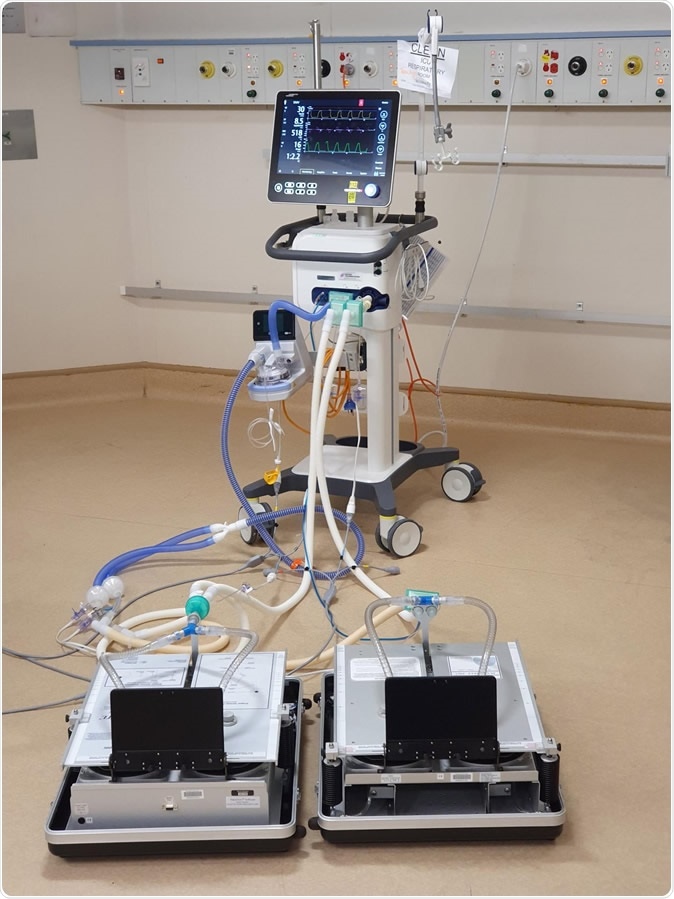Australian researchers have found that in cases of “extreme emergencies,” a single ventilator could be used between multiple patients of COVID-19 who require ventilator support. These ventilators could be split between the critically ill patients with not only COVID-19 but also other respiratory illnesses, the team of Australian researchers found. The study titled, “'Ventilator splitting with differential driving pressures using commodity hospital equipment,” was published in the latest issue of the journal Anaesthesia.

Image of successful research in ventilator splitting. Image Credit: Monash University
A new device was created whereby a single ventilator could be shared between multiple users. This could be life-saving in dire emergencies, say, researchers. The team states that this is a risky strategy because sharing ventilators could be dangerous for all the patients on it. The US Society of Critical Care Medicine and the American Association for Respiratory Care also says that it is unsafe for the patients and should not be implemented. The group said last month, “It is better to purpose the ventilator to the patient most likely to benefit than fail to prevent, or even cause, the demise of multiple patients.”
The COVID-19 pandemic has stretched the healthcare system to its maximum, and in places such as Italy, Spain, and the United States, the situation is getting worse by the day. In these regions, the intensive care units are housing more and more moribund patients with COVID-19, and there is a worldwide shortage of ventilators to meet these excessive needs.
Researchers and experts say that ventilator splitting has several problems, among which the main problem is different requirements of airflow, pressure, and volume of the different patients who are hooked on to it. A single machine cannot be programmed to meet the demands of different patients. There is also a risk of cross-infection, say experts.
What was done in this study?
This study led by Dr. Alexander Clarke, of the Royal Women’s Hospital in Melbourne, and Monash University’s Dr. Shaun Gregory, specify that they do not recommend splitting the ventilator. Their work was supported by other researchers, Dr. Andrew Stephens and Dr. Sam Liao from the department of Engineering, Monash University, and Dr. Timothy Byrne from Department of Intensive Care and Hyperbaric Medicine, Alfred Hospital, Melbourne. They write that in particularly extreme circumstances splitting the ventilator may help patients. They add that the key risks associated with ventilator splitting could be mitigated by their method.
Dr. Clarke said, “Patients with COVID-19 may develop progressive viral pneumonitis leading to severe respiratory failure. The combination of unprecedented disease burden and global supply chain disruption has resulted in worldwide shortages of medical equipment. Despite our advances in the practical application of ventilator splitting, the practice is unregulated and under-tested. But as the COVID-19 pandemic continues to grow, some countries, like the USA, may consider ventilator splitting on compassionate grounds. The United States of America Food and Drug Administration (FDA) has passed emergency use authorization for the splitting of ventilators.”
The new device they created using various parts available in the hospital would act as a flow restrictor, they explained. This restrictor can help doctors to control the airflow directed to different patients from the same ventilator. Clarke, in his statement, said, “It works by compensating for differences between patients, to an extent. So some patients need a lot of pressure, some patients don’t need so much pressure. By putting in the clamp, you can decrease the amount of pressure that one person gets.”
What did they find?
For this study, the team conducted experiments with their new device in simulated environments and used test lungs to check their device. This device helped them to modulate the air pressure, airflow, and volume that reached each of the test lungs. This is the first time a single ventilator could provide different pressures to two different lungs.
Clarke said, “We experimented with a few different devices to do this, and assembled some common hospital parts, that we should have available en-masse. Then we used some lung simulators, devices that share some of the characteristics of human lungs, and we used a standard ventilator in an intensive care unit, and took measurements using some engineering tools.”
“Our experiment has demonstrated that in order to deliver a safe tidal volume and airway pressure, a resistance mechanism is required on at least one inspiratory limb of the circuit. One way of achieving this is through the use of a tracheal tube and Hoffman clamp - common, practical items found in hospitals,” co-author, Dr. Gregory said.
Implications
Clarke explained that these results are far from absolutely conclusive but could be life-saving in dire situations. He said, “Getting more ventilators is mostly a logistics problem. This is a stopgap measure for that. It’s a device that none of us ever want to see used, and it’s really just about something we can get up and running very quickly, using the parts you can scramble together.” He added, “While ventilator splitting has, at face value, validity in addressing ventilator shortages, we agree that on sober reflection, it is a solution that needs to be weighed up carefully as it may cause more harm than good.”
Gregory added, “While the discovery is promising, the use of this method in the clinical context has not been validated, and we don’t recommend its wider use without further trials. We are hopeful of one day being able to get great surety with this approach to ventilator splitting so we can help save lives in dire cases of emergency.”
Journal reference:
Clarke, A., Stephens, A., Liao, S., Byrne, T. and Gregory, S. (2020), Coping with COVID‐19: ventilator splitting with differential driving pressures using standard hospital equipment. Anaesthesia. Accepted Author Manuscript. doi:10.1111/anae.15078, https://onlinelibrary.wiley.com/doi/abs/10.1111/anae.15078